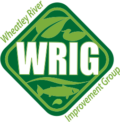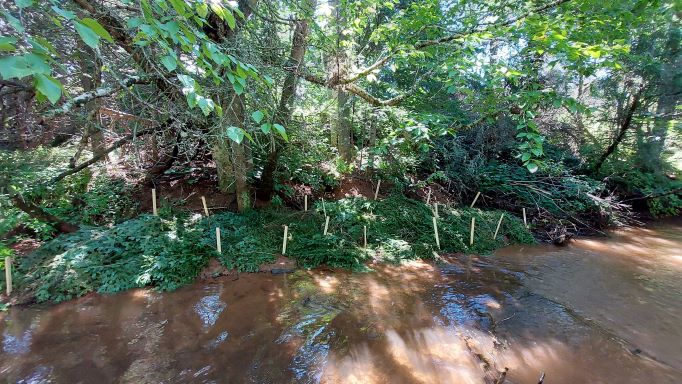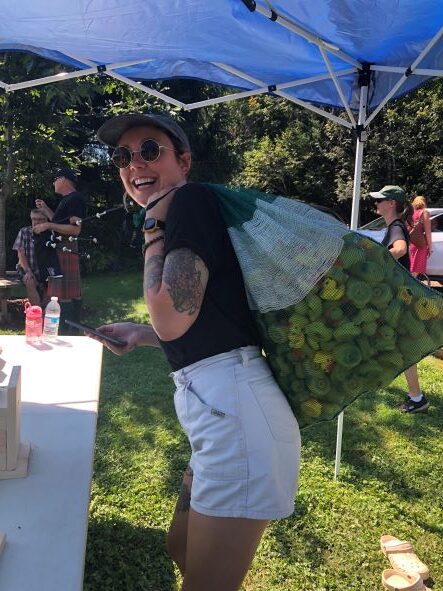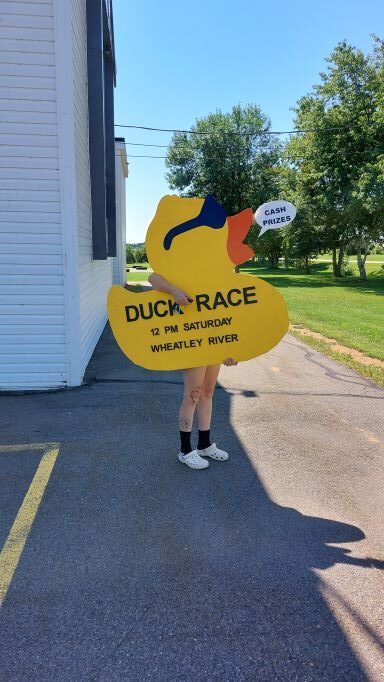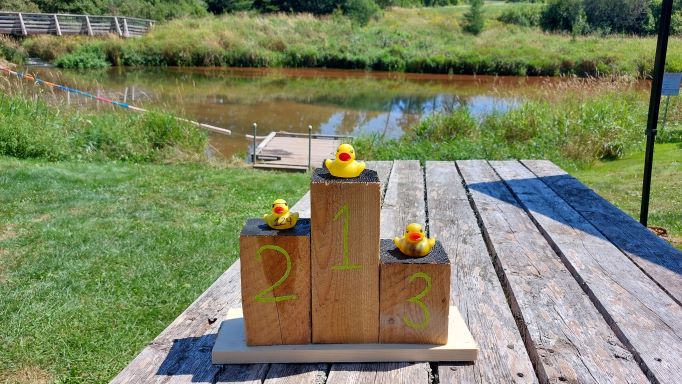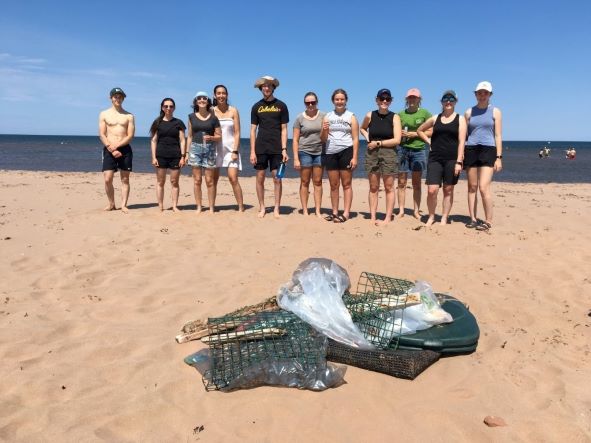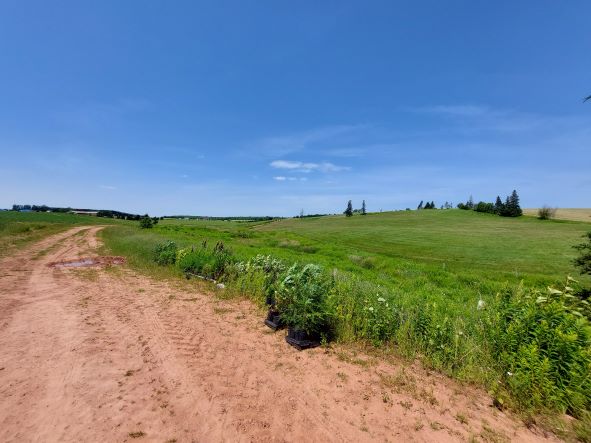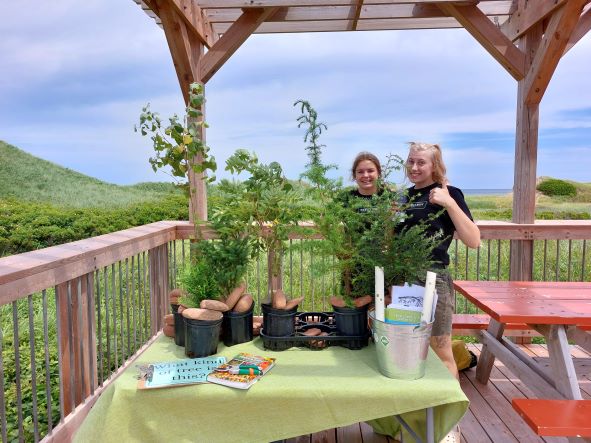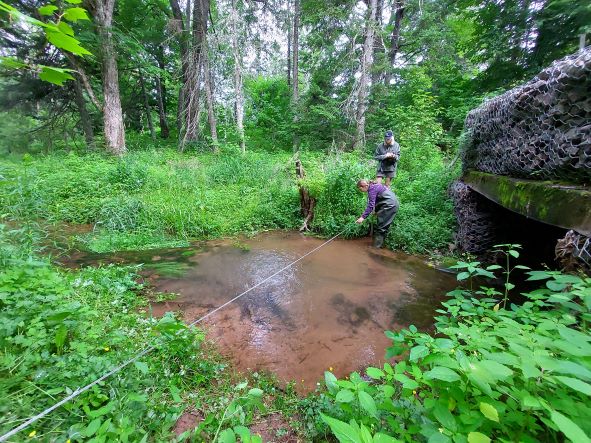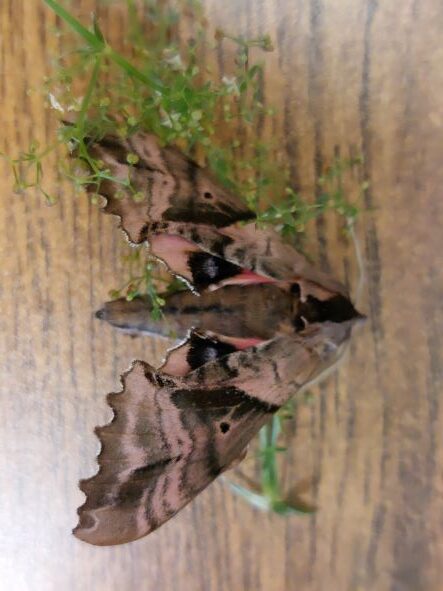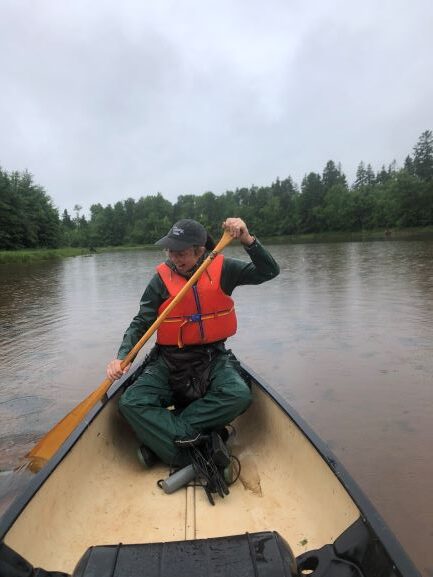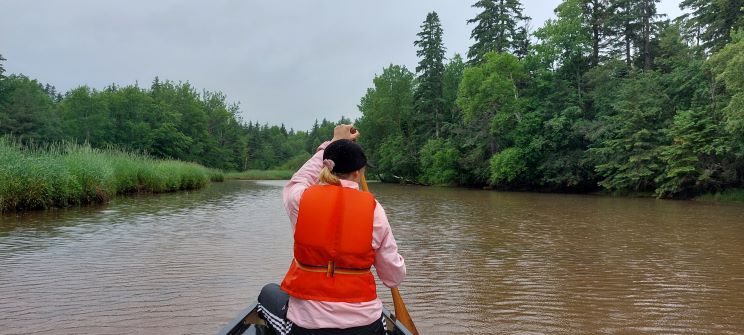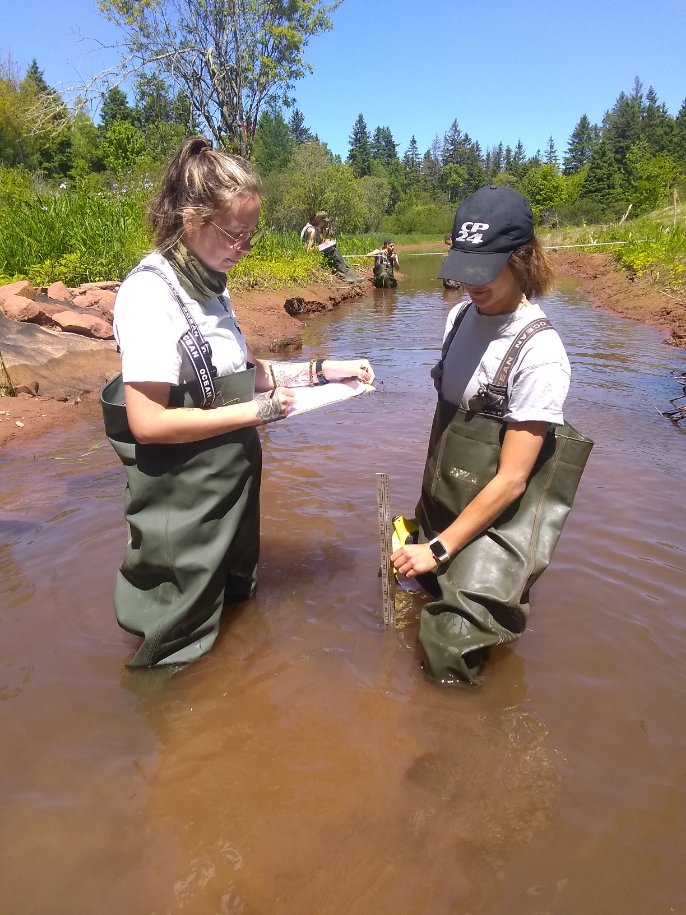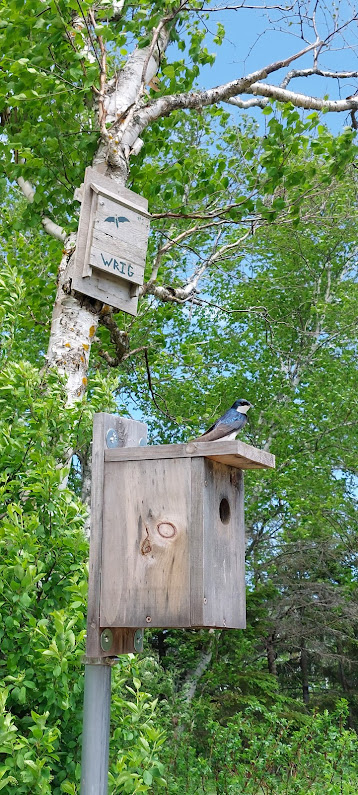WEEK 14: August 22-26
The final week!
The season flew by and we are sad to see the summer 2022 crew go!
For the last week, the crew has stayed busy. Throughout the summer, the crew worked on clearing a section of stream that had large blockages and a lot of alder overgrowth. In the final week, this section of the stream had its first pass completed. The work is not yet done but it has been much improved. On the most recent visit to the stream, it was noted that the substrate was beginning to show a gravel bottom rather than silt. A good sign for a healthy stream!
This week at Beach Hut was a fun one! Although the weather was not very cooperative, Cavendish Beach was still a busy spot to be. This week the crew talked about different projects and the work that watersheds do. Using the summer report board as a talking point, many visitors stopped to chat about the area, ask questions about the watershed, and talk about how beautiful PEI is.
At the end of the week, the crew prepped for the dredging of Rackham’s Pond and conducted the last anoxia survey for 2022.
Ella, Robyn and Bowie took the canoe through Wheatley River with the YSI, they monitored the quality of the water in the river and estuary.
Later, the crew met with Rosie from Fish and Wildlife to discuss different measures to ensure the safety of fish throughout the dredging process of Rackham’s Pond. Afterwards, the silt boom was prepped and materials were gathered to prepare for Monday morning.
In celebration of a great summer, the crew went to Rustico for icecream and enjoyed their last day of work together!
WEEK 13: August 15-20
Duck Race Week!!
This week started out with the installation of brush mats. In an area that is susceptible to soil run-off near an agricultural field, the crew built brush mats along the stream bank on point bars. Brush mats are structures made with wooden stakes, biodegradable twine, and branches of coniferous trees. They are placed on point bars (inside corners of stream bends) to catch sediment in the branch needles from the streams & stream banks to improve water quality. Brush mats can restore banks & streams to their former glory.
Mid-week, the crew continued on with stream clearing! With help from HCWG, the crew removed large blockages and islands that had formed in response to the blockages. Now the streams will start to return to their natural meander.
The week wrapped up with preparation for the annual Wheatley River Duck Race! The race was held on Saturday and the turnout was great. Over 300 rubber ducks raced down Rackham’s Pond to the finish line!
WEEK 11&12: August 2-12
To the streams! The crew took the streams to install brush mats, and remove blockages and alders.
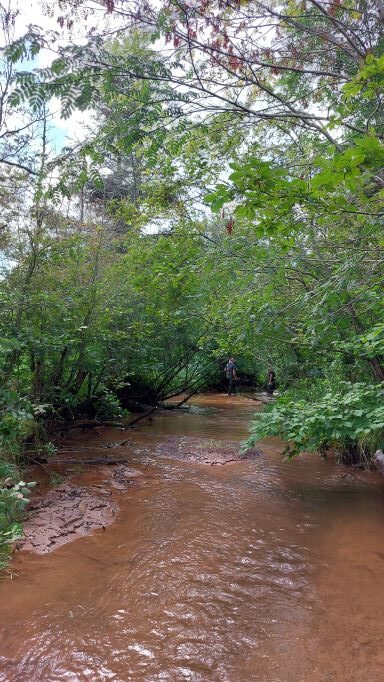
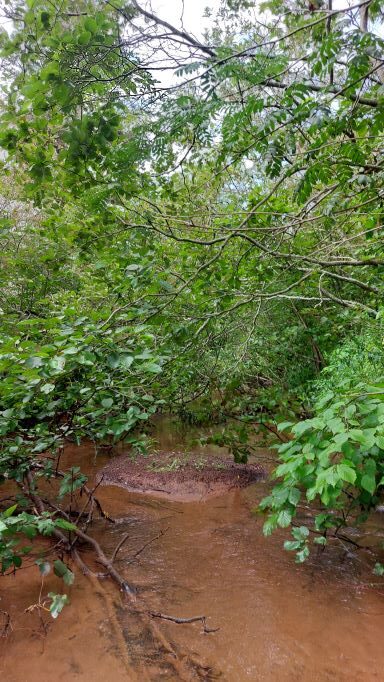
On August 4th, the crew teamed up with Hunter Clyde Watershed Group and The Trout River Environmental Committee for a clean-up at Barachois Beach!
Throughout the week, routine water quality monitoring was completed as well as tree checks of the previously planted trees.
WEEK 10: July 25-29
Amidst this week’s heatwave, the crew finished tree planting! This season we planted 500 native tree and shrub species. To ensure that the trees have a better survival rate, the crew returned a few times to water each tree.
On Tuesday, the crew teamed up with Parks Canada and TREC at Cavendish Beach National Park for the weekly Beach Hut. This week we discussed shorebirds, bats, watershed activities and more!
Stream clearing began on Friday! The crew began work in a stream located near the Art Ford Cross Road. The crew walks the stream and removes any blockage that could impede fish passage and disrupt the flow of water.
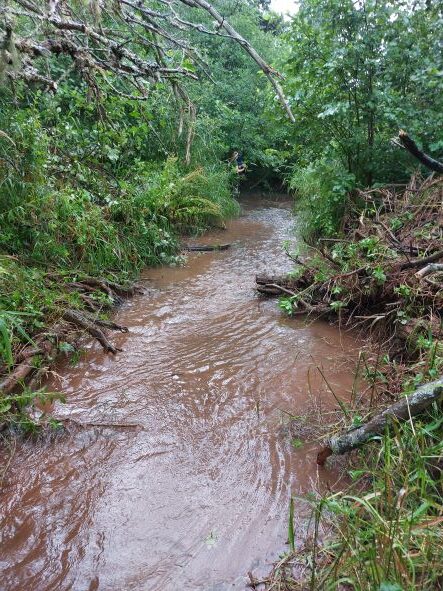
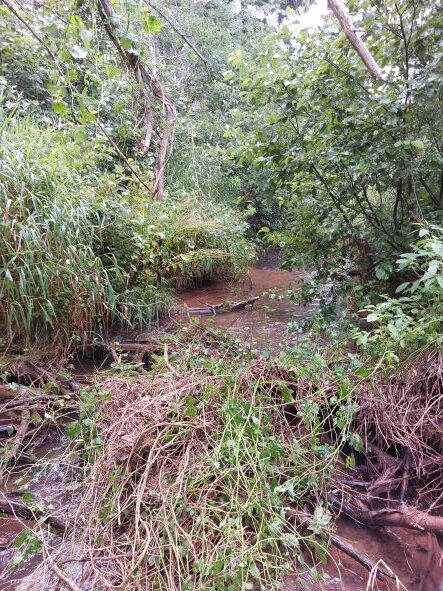
WEEK 9: July 18-22
The crew is at their second site for tree planting and spent the week planting, watering, pruning and weed whacking. This site is a stream that runs between a dirt road and an agricultural field that is lacking in tree cover. The species that were planted there were: yellow birch, mountain ash, black spruce, tamarack, eastern hemlock, willow, eastern cedar, sweet gale, Aronia sp, and spirea sp. Throughout the week, the crew returns to water the planted tree and shrubs to help encourage growth.
Mid-week, the crew completed a routine water quality monitoring as well as surveyed the waterways for sediment runoff caused by heavy rainfall. Since streams and rivers run clear, it is easy to spot a body of water affected by runoff. The water will no longer be clear but rather murky and red in colour due to the rain washing the topsoil from fields and dirt roads into streams. It becomes an issue because it is harmful to the surrounding habitat. In many cases, the run-off deposits topsoil, organic matter, fertilizers, limes, pesticides or bacteria from manure into the streams. The streams drain into an estuary and can lead to anoxic events. One of the ways the watershed groups help to manage this problem is by planting trees along stream banks which will help catch the sediment before it reaches the water.
WEEK 8: July 11-15
Tree planting was a large part of this week. The crew planted over 200 different native tree and shrub species along a section of a stream that lacked vegetation. The stream runs through farmland and is susceptible to sediment buildup and high nitrate levels. Planting trees and shrubs will help build up a healthy riparian area that will reduce the amount of run-off, help lower the water temperature and in turn, create a healthy ecosystem.
The crew attended their first Beach Hut of the summer at Cavendish Beach. The event takes place every second Tuesday and a different topic is presented to the locals and tourists. This week, Robyn, Daphne, and Ella joined up with Park Canada and discussed the importance of native tree species to the Acadian forest.
Mid-week, the crew split up for water quality monitoring and electrofishing refresher course. Robyn travelled to Dromore to join with other watershed groups and the PEI Watershed Alliance for electrofishing. Electrofishing is a fishing technique that uses direct current electricity flowing between a submerged cathode and anode. The fish become stunned for approximately 2 seconds, allowing a person to net them quickly. When netted, the fish are placed into holding bins for surveying and released shortly after.
The week ended with Robyn and Daphne conducting a routine anoxia survey in the Wheatley River. They took out the canoe and travelled from the Wheatley River bridge to the Oyster Bed Bridge. Along the way, they would deploy the YSI and answer a questionnaire in regards to the colour, smell, and content of the water in a specific location. When out on the water, they carefully removed the flower heads of Yellow Flag Iris along the stream banks. Yellow flag iris is non-native and invades wetlands, streams, and shallow ponds. This plant reproduces through seed dispersal, horizontal roots, and when pieces of the roots break off, which can form new plants. The seeds float on the water in spring and fall, causing them to spread quickly. The extensive root system creates a thick mat that damages wildlife habitat, reduces water flow, and crowds out native vegetation. It can be toxic to humans and animals.
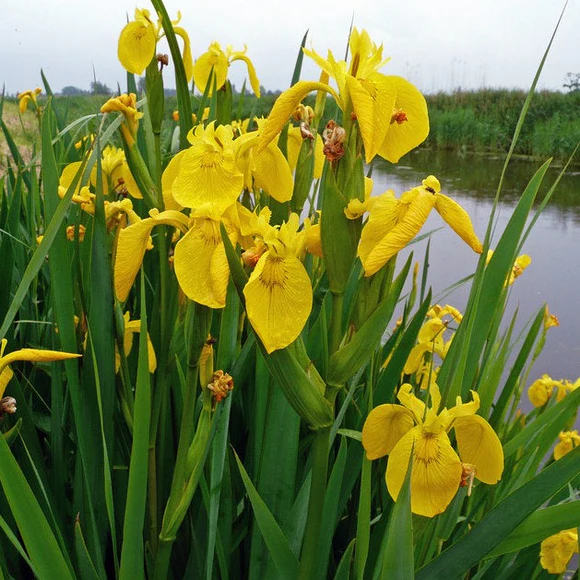
While out in the field, the crew like to explore and take note of anything interesting in the area. Here are the week’s note-worthy finds!

WEEK 7: July 4-8
This week began with Robyn and Ella attending a watershed worker training course at Lot 11. The training course was led by Mary Finch and covered certain topics such as fish species and the different methods for stream and habitat restoration. They were given the opportunity to see different structures placed in the stream in Trout River’s watershed and the outcomes each had. These structures included digger logs, cover logs, deflectors, brush mats, and more. Marika and Daphne spent this day working at Rackham’s Pond where they successfully reinstalled fish cover boards in the stream.

The crossing assessments were completed this week! The girls have successfully assessed 124 different crossing structures and determined if they were adequate or not for a fish to swim upstream through.
Mid week, Robyn and Ella preformed the water quality monitoring in the rain. During this time ,they surveyed the waterways and indicated areas that the streams were “red” due to sediment runoff. Sediment ends up in the streams after rain or heavy wind events and come from dirt roads or agricultural fields. This has a negative impact on the streams and the wildlife within. The sediment can suffocate the fish and the pesticides and fertilizers negatively effect the quality of the water. It is important to know which areas have the higher amount of runoff for future prevention methods.

Later in the week, the crew met with other watersheds groups for a tour of a tree nursery and greenhouse at J Frank Gaudet Tree Nursery. Each season, watersheds groups are provided with native tree and shrub species for tree planting and this is where they come from. While on the tour, they were able to see the process that goes into growing each individual tree species from seed to sapling and back to the forests of Prince Edward Island.
The week wrapped up with the collecting of macro invertebrate samples from different streams within the watershed. The macroinvertebrates were collected using the kick net method. The samples were collected from the net and properly stored for the sorting and identifying each species. Macroinvertebrates are important for stream assessments because certain species represent either poor stream conditions or good stream conditions.

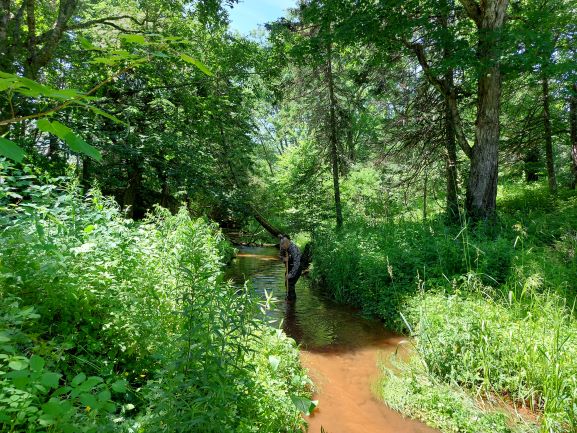
WEEK 6: June 27-July 1
Happy Canada Day!! We spent the last week of June completing more crossing assessments. We have now assessed over 100 different crossings over streams and rivers within the boundaries of the Wheatley River Watershed. Throughout the crossing assessments, the girls have come across many different things. Of note: baby brook trout, muskrats, barred owls, old dump sites, abandoned trucks and tractors, and ruffed grouse!
Daphne joined the team this week and jumped right in for water quality monitoring. While the girls were out testing the waters, they came across bittersweet nightshade. Although bittersweet nightshade is widespread and established in the area, it is considered a non-native invasive plant species and can cause negative effects to the health of a stream and its riparian area.
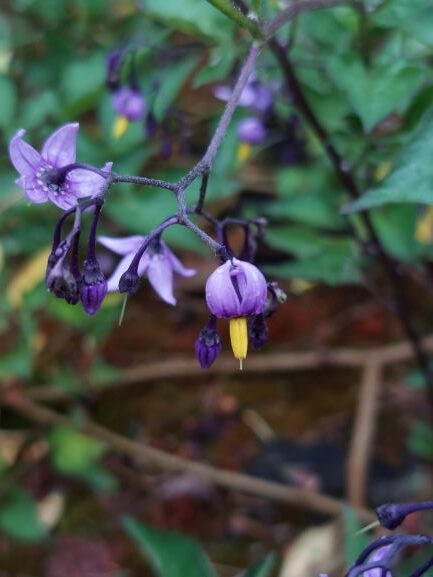
The girls took a field trip to MacPhail’s Woods with other watershed groups for a workshop led by Gary to learn more about native tree and shrub species. They learned tree identification tips and tricks and were taught the importance of maintaining diversity within forests and riparian areas. Gary provided them important information about tree planting and proper spacing techniques.
Near the end of the week, the girls went to Rackham’s Pond for cross section surveys in preparation for the dredging of the stream. This included taking water depth and bank height measurements every 10 centimeters across the stream.


For Canada Day, Maggie teamed up with Victoria and Nicole from the Hunter Clyde Watershed Group for a tree giveaway! Together they went to North Rustico for the parade and handed out red oaks, red maples, sugar maples, white ash, hemlock and yellow birch trees to encourage the planting of native tree species.

WEEK 5: June 20-24
We began this week in Hornes Creek to complete another section of crossing assessments. We have now completed more than half of the site checks for the watershed and have become experts at navigating through the thickets. On Wednesday, Robyn and Ella completed the weekly water quality monitoring. They used a YSI to check the quality of the water and measured the streams water depth, flow rate and bank width.


Robyn and Ella teamed up with Shayla from the Trout River Environmental Committee to assist with a Rapid Geomorphic Assessment within TREC’s watershed. The week was wrapped up with water quality monitoring in the Wheatley River estuary. Ella and Robyn spent the day canoeing from the Wheatley River bridge to Oyster Bed bridge. Throughout this journey, they made multiple stops to check the quality of water using the YSI and record observations relating to anoxic events.
WEEK 4: June 13-17
Crossing assessments, tree checks, baby whales, and more!!
This week’s crossing assessments consisted of bushwhacking and owl watching! Two barred owls were heard calling to each other so we followed the “whos” and spotted a barred owl perched on an old birch tree. Soon after, we returned to the streams and enjoyed beautiful walks through the forest and discovered old roads and stream structures.
Tree checks and planting began this week! We returned to old sites where we pruned and watered trees planted from previous seasons. Planting native tree and shrub species is an important role that the watershed has in a community. Having healthy streams and waterways include a wide variety of native species to create a diverse ecosystem.
At the end of the week we WHALE-comed the crew from Project SculptShore to PEI. With a life-sized sculpture of a North Atlantic right whale calf, Liz and her friends are touring Atlantic Canada to assist in shoreline cleanups and to spread awareness about the entanglement of whales in fishing gear.
WEEK 3: June 6-10
Busy, busy, busy!
This week was jammed packed. It began with the weekly maintenance at Rackham’s pond, ended with Environmental Fun Day and was filled with crossing assessments and workshops in-between!
Marika and Ella tackled the crossing assessments. Crossing assessments entail measuring and surveying any stream crossing to ensure they will not negatively impact fish passage. While they did this, the field supervisor Robyn attended the Rapid Geomorphic Assessment workshop to better discover and understand the river corridor through data collection and interpretation. Mid week, we had kids from Immanuel Christian School visit Rackham’s Pond to help place signs around the park to discourage littering and to keep the river clean!
The week wrapped up at Campbell’s Pond for our 12th annual Environmental Fun Day! We had nearly 100 kids from 3 local schools join us and the Hunter-Clyde Watershed Group for an active learning day. The kids had an chance to learn about nature, in nature, as they visited different presenters around the pond.
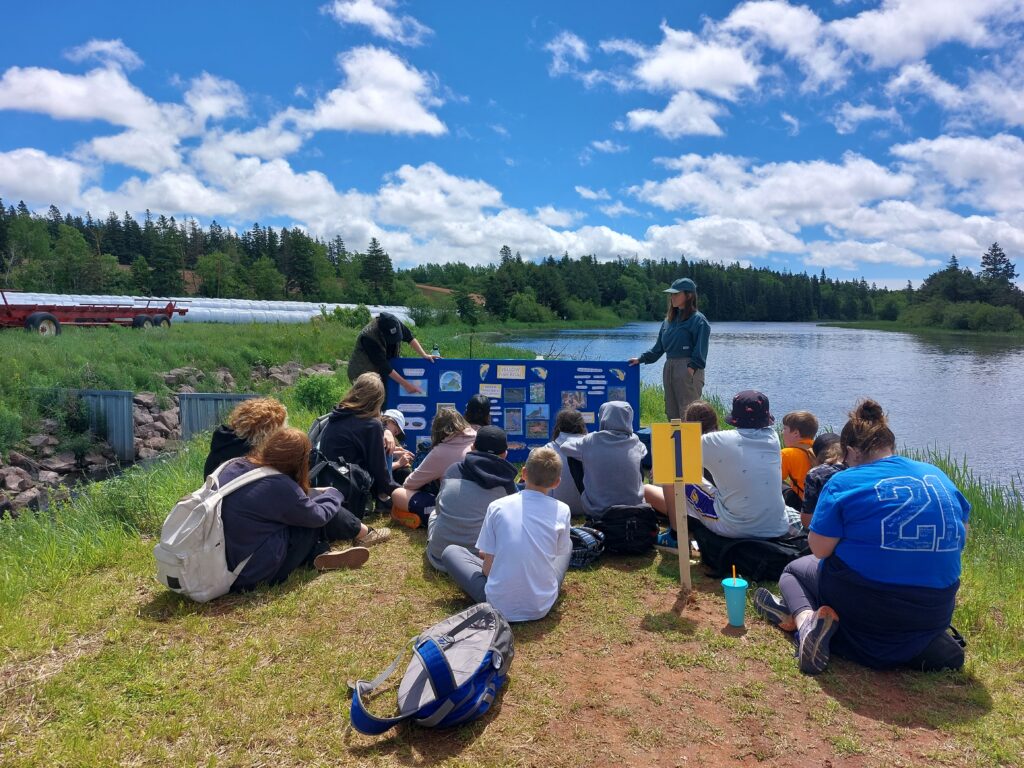
WEEK 2: May 30-June 3
And just like that it’s June!
After that, it was time to check the tree swallow nest boxes for inhabitants and eggs! Tree swallows are easy to find near fields or areas adjacent to water. To find out if a nest box is being used by a tree swallow is typically an easy check since you can often see them flying around the box or perching on top of them.
Midweek we did the routine water quality monitoring. We use a YSI machine that allows us to check the waters in the local streams and creeks for the temperature, dissolved oxygen, specific conductance, conductivity, total dissolved solids. salinity, pH, and nitrate levels. Later in the week, temperature loggers were set up and placed in waterways in Wheatley River.
The week was wrapped up with a canoe trip through the estuaries for more water quality monitoring as well as sorting out tree and shrub species that arrived for the planting days ahead!
WEEK 1: May 23-27
The summer season has officially begun!
This week we welcomed back last years team members as well as new team members. The first day out in the field was a beautiful one. We began the week by moving the EXTREMELY heavy floating dock back into the water at Rackham’s Pond. As challenging as it was, the team worked together and successfully placed the dock back into the pond. To celebrate their success, they powered up the weedwacker and lawn mower to tidy up the park area. The smell of fresh cut grass was a reward in itself for a job well done.
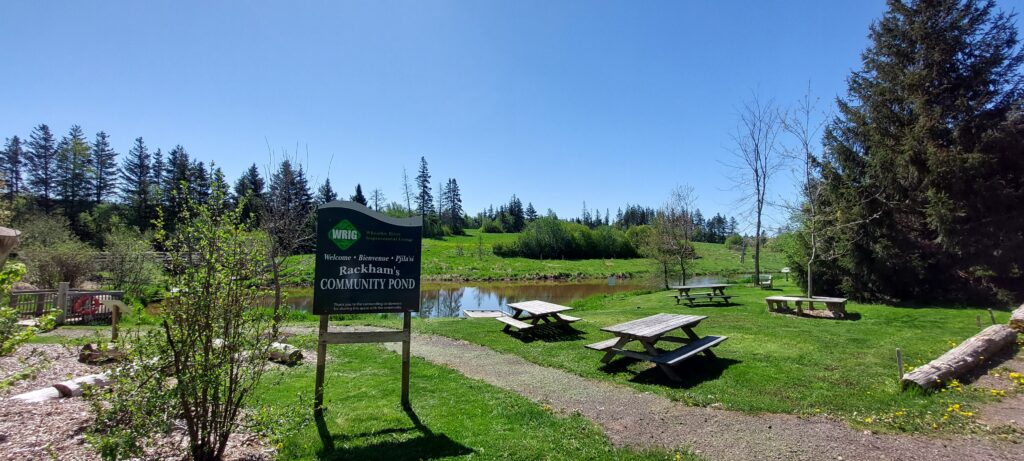
Next, the team ventured off to find the headwater locations of each stream within the Wheatley River Watershed. With GPS in hand, a journey was made to survey the areas of each headwater. Waypoints were taken to indicate each separate location as well as a visual survey that specified the condition that the headwaters were in.
To wrap up the week and prepare for the season ahead, the team constructed new nest boxes for tree swallows. The team proved themselves to be quite the handywomen as well as watershed technicians. We cannot wait for the new tenants of the nest boxes to enjoy their brand new homes here in the Wheatley River Watershed.
